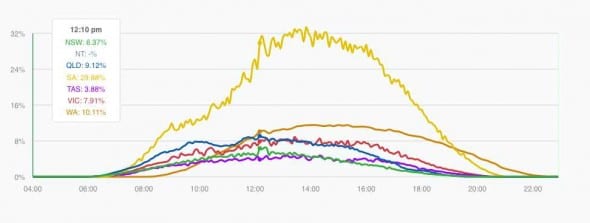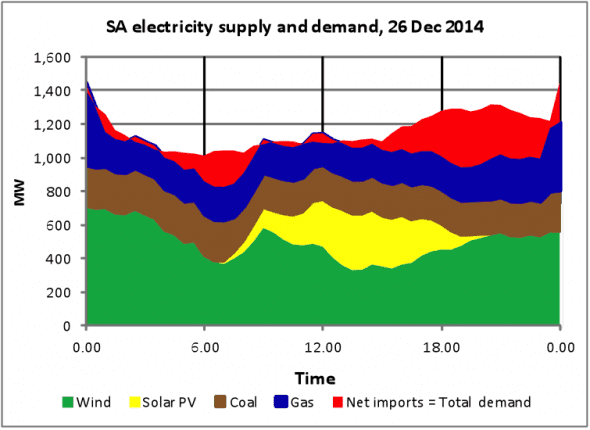Rooftop Solar In South Australia Met One Third Of State’s Daily Electricity Demand
Power to the people
Right on
-John Lennon
Someones gonna have to pay the price
-Journey
Greetings
Here's some pretty cool news. Solar and Wind are producing lots of power in Australia. Around 40% according to this article. They are shooting for 50% by 2025.
All very nice. Presumably while the wind blows or the sun shines, there is no need to run the coal and gas plants that provide back up. So less CO2 is emitted than would have been.
Solar and wind generation continue to get cheaper, so we should expect them to make greater inroads.
So how does this fit in with the fact that Google dropped its project of replacing fossil plants with renewable energy? After 5 years of study, they walked away. Why so gloomy? Here's what the Google engineers said
"At the start of RE<C, we had shared the attitude of many stalwart environmentalists: We felt that with steady improvements to today’s renewable energy technologies, our society could stave off catastrophic climate change. We now know that to be a false hope—but that doesn’t mean the planet is doomed.As we reflected on the project, we came to the conclusion that even if Google and others had led the way toward a wholesale adoption of renewable energy, that switch would not have resulted in significant reductions of carbon dioxide emissions. Trying to combat climate change exclusively with today’s renewable energy technologies simply won’t work; we need a fundamentally different approach. So we’re issuing a call to action. There’s hope to avert disaster if our society takes a hard look at the true scale of the problem and uses that reckoning to shape its priorities".
OK, so the Google folks couldn't accomplish what they wanted. What they wanted was a renewable setup without the coal and gas backup. In other words they needed a battery, and they wanted one that would be cheap enough so the entire system would be cheaper than coal.
So, batteries that cheap just aren't available today. But surely technology marches on! Surely Google would think so.
And they did. They took a look at the future, factoring in likly improvements based on
"...a study on the impact of clean energy innovation, using the consulting firm McKinsey & Co.’s low-carbon economics tool. Our study’s best-case scenario modeled our most optimistic assumptions about cost reductions in solar power, wind power, energy storage, and electric vehicles. In this scenario, the United States would cut greenhouse gas emissions dramatically: Emissions could be 55 percent below the business-as-usual projection for 2050.
Then they ran the numbers against the goal of Harson's goal of 350 ppm
"Even if every renewable energy technology advanced as quickly as imagined and they were all applied globally, atmospheric CO2 levels wouldn’t just remain above 350 ppm; they would continue to rise exponentially due to continued fossil fuel use. So our best-case scenario, which was based on our most optimistic forecasts for renewable energy, would still result in severe climate change, with all its dire consequences: shifting climatic zones, freshwater shortages, eroding coasts, and ocean acidification, among others. Our reckoning showed that reversing the trend would require both radical technological advances in cheap zero-carbon energy, as well as a method of extracting CO2 from the atmosphere and sequestering the carbon.
As I see it, the major problem is cost. It's not that we couldn't come up with the batteries. Its that we would be willing to pay for it! It will only come to pass, if the technology can be delivered at "high profit margin"
"In the electricity sector, that bottom line comes down to the difference between the cost of generating electricity and its price. In the United States alone, we’re aiming to replace about 1 terawatt of generation infrastructure over the next 40 years. This won’t happen without a breakthrough energy technology that has a high profit margin. Subsidies may help at first, but only private sector involvement, with eager money-making investors, will lead to rapid adoption of a new technology. Each year’s profits must be sufficient to keep investors happy while also financing the next year’s capital investments. With exponential growth in deployment, businesses could be replacing 30 gigawatts of installed capacity annually by 2040.This type of analysis has some merit, I think. First Google has an incentive to try to find the "next big thing", so I have no reason to think they would down play something usefu;. Second their assumption that it woun't happen unless someone makes a profit, is pretty well in tune with the modern ethos, and in particular the approach of the folks who now control both houses of Congress.
So, my take away, is not necessarily that it can't be done. It just won't be cheap. And if we aren't willing to accept that here's their best guess map of the future

-------
By Giles Parkinson on 12 January 2015
We’ve documented the growing impact of rooftop solar on the electricity market in South Australia on many occasions, but on Boxing Day just passed it may have hit a new record.
According to this graph from the Australian Photovoltaic Institute’s Solar Map, rooftop solar contributed up to one third of total demand in the state in the middle of the day, and at least 30 per cent from 11.30am to 3.30pm.
The South Australian grid operator has recognised the benefits of rooftop solar on the grid – it says it has pushed the peak back much later in the day, reduced the breadth of peak demand (much to the chagrin of the conventional generators who relied on the peaks for income), and reduced stress on the grid at peak times.
Indeed, this graph here shows over the three days around Boxing Day. It registers only grid demand, so not rooftop solar. Notice the dips during the day – from the grid’s point of view, off-peak now comes in the middle of the day.
But here is what the total electricity demand looks like with solar included – courtesy of the APVI Solar Map data and some chart-work from energy analyst Hugh Saddler at Pitt&Sherry.
It shows that wind accounted for nearly half of total demand on December 26. Which means that wind and solar accounted for around two thirds of total demand for large parts of the daytime hours, and just over half over the 24-hour period.
Saddler notes that total electricity demand in SA on December 26 was low for summer because the day was relatively cool (maximum temperature in Adelaide 23.4 deg. C) and also a public holiday.
“That said, the data show that there is no technical impediment to renewable sources of generation supplying a high proportion of total electricity requirements,” Saddler says.
” The combined share of wind and solar for the whole day (midnight to midnight) was 52 per cent. The data also show the benefits of technology diversity in renewable generation. Wind and solar generation complement each other when, as is very often the case in SA, there is more wind overnight than during the day.
“This demonstrates that, when Australia eventually gets serious about transforming its electricity industry towards a low emission future, both technologies should be important parts of the total generation mix.”
And, Saddler adds, the data shows the economic benefits for electricity consumers of interconnections between states. For most of the day low cost brown coal electricity imported from Victoria displaced higher cost local coal and gas generation in SA, but on a couple of occasions surplus generation from wind in SA flowed east, helping to keep prices in Victoria slightly lower than they would otherwise have been.
There are several things to note about South Australia. It has the highest penetration of rooftop solar in the country,with more than 23 per cent of all customers having solar. It also has nearly 50 per cent of all wind capacity in the country, at around 1,500MW.
And as a result of all that, one of its two major coal generators is mothballed, and the other operators only part of the time. And its biggest gas plant, the Torrens facility owned by AGL Energy, will close half its capacity too because it is no longer needed.
Indeed, on an annualised basis, the state now meets around 40 per cent of total demand through wind and solar. That is expected to jump significantly in coming years.
The state government has a 50 per cent target by 2025, but in reality it could go much higher than that – even to 100 per cent - particularly if the national renewable energy target remains in place.
The prevalence of variable wind and solar underlines the importance of energy storage going forward. But battery storage is already proving to be economic, particularly in the role of avoiding costly upgrades and extensions to the network of poles and wires.
This in turn will encourage more renewables. The SA grid operator itself suggests that the future may lie in a series of renewables based micro grids based – it sees little future for conventional generators, or even conventional electricity retailers.





0 Comments:
Post a Comment
Subscribe to Post Comments [Atom]
<< Home